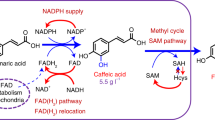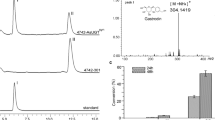Abstract
As a natural phenolic acid product of plant source, caffeic acid displays diverse biological activities and acts as an important precursor for the synthesis of other valuable compounds. Limitations in chemical synthesis or plant extraction of caffeic acid trigger interest in its microbial biosynthesis. Recently, Saccharomyces cerevisiae has been reported for the biosynthesis of caffeic acid via episomal plasmid-mediated expression of pathway genes. However, the production was far from satisfactory and even relied on the addition of precursor. In this study, we first established a controllable and stable caffeic acid pathway by employing a modified GAL regulatory system to control the genome-integrated pathway genes in S. cerevisiae and realized biosynthesis of 222.7 mg/L caffeic acid. Combinatorial engineering strategies including eliminating the tyrosine-induced feedback inhibition, deleting genes involved in competing pathways, and overexpressing rate-limiting enzymes led to about 2.6-fold improvement in the caffeic acid production, reaching up to 569.0 mg/L in shake-flask cultures. To our knowledge, this is the highest ever reported titer of caffeic acid synthesized by engineered yeast. This work showed the prospect for microbial biosynthesis of caffeic acid and laid the foundation for constructing biosynthetic pathways of its derived metabolites.
Key points
-
Genomic integration of ORgTAL, OHpaB, and HpaC for caffeic acid production in yeast.
-
Feedback inhibition elimination and Aro10 deletion improved caffeic acid production.
-
The highest ever reported titer (569.0 mg/L) of caffeic acid synthesized by yeast.



Similar content being viewed by others
Data availability
All experimental data and strains constructed in this study will be made available from the corresponding author upon reasonable request from readers.
References
Berner M, Krug D, Bihlmaier C, Vente A, Muller R, Bechthold A (2006) Genes and enzymes involved in caffeic acid biosynthesis in the actinomycete Saccharothrix espanaensis. J Bacteriol 188(7):2666–2673. https://doi.org/10.1128/JB.188.7.2666-2673.2006
Bloch SE, Schmidt-Dannert C (2014) Construction of a chimeric biosynthetic pathway for the de novo biosynthesis of rosmarinic acid in Escherichia coli. Chembiochem 15(16):2393–2401. https://doi.org/10.1002/cbic.201402275
Brachmann CB, Davies A, Cost GJ, Caputo E, Li J, Hieter P, Boeke JD (1998) Designer deletion strains derived from Saccharomyces cerevisiae S288C: a useful set of strains and plasmids for PCR-mediated gene disruption and other applications. Yeast 14(2):115–132. https://doi.org/10.1002/(SICI)1097-0061(19980130)14:2<115::AID-YEA204>3.0.CO;2-2
Cao M, Gao M, Suastegui M, Mei Y, Shao Z (2020) Building microbial factories for the production of aromatic amino acid pathway derivatives: from commodity chemicals to plant-sourced natural products. Metab Eng 58:94–132. https://doi.org/10.1016/j.ymben.2019.08.008
Chao PC, Hsu CC, Yin MC (2009) Anti-inflammatory and anti-coagulatory activities of caffeic acid and ellagic acid in cardiac tissue of diabetic mice. Nutr Metab (Lond) 6:33. https://doi.org/10.1186/1743-7075-6-33
Chen JH, Ho CT (1997) Antioxidant activities of caffeic acid and its related hydroxycinnamic acid compounds. J Agric Food Chem 45(7):2374–2378. https://doi.org/10.1021/jf970055t
Chen Z, Sun X, Li Y, Yan Y, Yuan Q (2017) Metabolic engineering of Escherichia coli for microbial synthesis of monolignols. Metab Eng 39:102–109. https://doi.org/10.1016/j.ymben.2016.10.021
Choi O, Wu CZ, Kang SY, Ahn JS, Uhm TB, Hong YS (2011) Biosynthesis of plant-specific phenylpropanoids by construction of an artificial biosynthetic pathway in Escherichia coli. J Ind Microbiol Biotechnol 38(10):1657–1665. https://doi.org/10.1007/s10295-011-0954-3
Dickinson JR, Salgado LE, Hewlins MJ (2003) The catabolism of amino acids to long chain and complex alcohols in Saccharomyces cerevisiae. J Biol Chem 278(10):8028–8034. https://doi.org/10.1074/jbc.M211914200
Espindola KMM, Ferreira RG, Narvaez LEM, Silva Rosario ACR, da Silva AHM, Silva AGB, Vieira APO, Monteiro MC (2019) Chemical and pharmacological aspects of caffeic acid and its activity in hepatocarcinoma. Front Oncol 9:541. https://doi.org/10.3389/fonc.2019.00541
Fordjour E, Adipah FK, Zhou S, Du G, Zhou J (2019) Metabolic engineering of Escherichia coli BL21 (DE3) for de novo production of L-DOPA from D-glucose. Microb Cell Factories 18(1):74. https://doi.org/10.1186/s12934-019-1122-0
Furuya T, Arai Y, Kino K (2012) Biotechnological production of caffeic acid by bacterial cytochrome P450 CYP199A2. Appl Environ Microbiol 78(17):6087–6094. https://doi.org/10.1128/AEM.01103-12
Gao M, Cao M, Suastegui M, Walker J, Rodriguez Quiroz N, Wu Y, Tribby D, Okerlund A, Stanley L, Shanks JV, Shao Z (2017) Innovating a nonconventional yeast platform for producing shikimate as the building block of high-value aromatics. ACS Synth Biol 6(1):29–38. https://doi.org/10.1021/acssynbio.6b00132
Gietz RD, Schiestl RH (2007) High-efficiency yeast transformation using the LiAc/SS carrier DNA/PEG method. Nat Protoc 2(1):31–34. https://doi.org/10.1038/nprot.2007.13
Gold ND, Gowen CM, Lussier FX, Cautha SC, Mahadevan R, Martin VJ (2015) Metabolic engineering of a tyrosine-overproducing yeast platform using targeted metabolomics. Microb Cell Factories 14:73. https://doi.org/10.1186/s12934-015-0252-2
Gottardi M, Reifenrath M, Boles E, Tripp J (2017) Pathway engineering for the production of heterologous aromatic chemicals and their derivatives in Saccharomyces cerevisiae: bioconversion from glucose. FEMS Yeast Res 17(4). https://doi.org/10.1093/femsyr/fox035
Gupta JC, Mukherjee KJ (2002) Stability studies of recombinant Saccharomyces cerevisiae in the presence of varying selection pressure. Biotechnol Bioeng 78(5):475–488. https://doi.org/10.1002/bit.10213
Hartmann M, Schneider TR, Pfeil A, Heinrich G, Lipscomb WN, Braus GH (2003) Evolution of feedback-inhibited β /α barrel isoenzymes by gene duplication and a single mutation. Proc Natl Acad Sci U.S.A 100(3):862–867. https://doi.org/10.1073/pnas.0337566100
Hernández-Chávez G, Martinez A, Gosset G (2019) Metabolic engineering strategies for caffeic acid production in Escherichia coli. Electronic J Biotechn 38:19–26. https://doi.org/10.1016/j.ejbt.2018.12.004
Huang Q, Lin Y, Yan Y (2013) Caffeic acid production enhancement by engineering a phenylalanine over-producing Escherichia coli strain. Biotechnol Bioeng 110(12):3188–3196. https://doi.org/10.1002/bit.24988
Ikeda K, Tsujimoto K, Uozaki M, Nishide M, Suzuki Y, Koyama AH, Yamasaki H (2011) Inhibition of multiplication of herpes simplex virus by caffeic acid. Int J Mol Med 28(4):595–598. https://doi.org/10.3892/ijmm.2011.739
Jones JA, Collins SM, Vernacchio VR, Lachance DM, Koffas MA (2016) Optimization of naringenin and p-coumaric acid hydroxylation using the native E. coli hydroxylase complex, HpaBC. Biotechnol Prog 32(1):21–25. https://doi.org/10.1002/btpr.2185
Jones JA, Vernacchio VR, Collins SM, Shirke AN, Xiu Y, Englaender JA, Cress BF, McCutcheon CC, Linhardt RJ, Gross RA, Koffas MAG (2017) Complete biosynthesis of anthocyanins using E. coli polycultures. Mbio 8(3):e00621–e00617. https://doi.org/10.1128/mBio.00621-17
Kim YH, Kwon T, Yang HJ, Kim W, Youn H, Lee JY, Youn B (2011) Gene engineering, purification, crystallization and preliminary X-ray diffraction of cytochrome P450 p-coumarate-3-hydroxylase (C3H), the Arabidopsis membrane protein. Protein Expr Purif 79(1):149–155. https://doi.org/10.1016/j.pep.2011.04.013
Koopman F, Beekwilder J, Crimi B, van Houwelingen A, Hall RD, Bosch D, van Maris AJ, Pronk JT, Daran JM (2012) De novo production of the flavonoid naringenin in engineered Saccharomyces cerevisiae. Microb Cell Factories 11:155. https://doi.org/10.1186/1475-2859-11-155
Li Y, Mao J, Liu Q, Song X, Wu Y, Cai M, Xu H, Qiao M (2020) De novo biosynthesis of caffeic acid from glucose by engineered Saccharomyces cerevisiae. ACS Synth Biol 9(4):756–765. https://doi.org/10.1021/acssynbio.9b00431
Lin YH, Yan YJ (2012) Biosynthesis of caffeic acid in Escherichia coli using its endogenous hydroxylase complex. Microb Cell Factories 11:42. https://doi.org/10.1186/1475-2859-11-42
Liu D, Li B, Liu H, Guo X, Yuan Y (2017) Profiling influences of gene overexpression on heterologous resveratrol production in Saccharomyces cerevisiae. Front Chem Sci Eng 11(1):117–125. https://doi.org/10.1007/s11705-016-1601-3
Liu L, Liu H, Zhang W, Yao M, Li B, Liu D, Yuan Y (2019a) Engineering the biosynthesis of caffeic acid in Saccharomyces cerevisiae with heterologous enzyme combinations. Engineering 5(2):287–295. https://doi.org/10.1016/j.eng.2018.11.029
Liu Q, Yu T, Li X, Chen Y, Campbell K, Nielsen J, Chen Y (2019b) Rewiring carbon metabolism in yeast for high level production of aromatic chemicals. Nat Commun 10(1):4976. https://doi.org/10.1038/s41467-019-12961-5
Lopez-Nieves S, Pringle A, Maeda HA (2019) Biochemical characterization of TyrA dehydrogenases from Saccharomyces cerevisiae (Ascomycota) and Pleurotus ostreatus (Basidiomycota). Arch Biochem Biophys 665:12–19. https://doi.org/10.1016/j.abb.2019.02.005
Luttik MA, Vuralhan Z, Suir E, Braus GH, Pronk JT, Daran JM (2008) Alleviation of feedback inhibition in Saccharomyces cerevisiae aromatic amino acid biosynthesis: quantification of metabolic impact. Metab Eng 10(3-4):141–153. https://doi.org/10.1016/j.ymben.2008.02.002
Lv X, Wang F, Zhou P, Ye L, Xie W, Xu H, Yu H (2016) Dual regulation of cytoplasmic and mitochondrial acetyl-CoA utilization for improved isoprene production in Saccharomyces cerevisiae. Nat Commun 7:12851. https://doi.org/10.1038/ncomms12851
Lyu X, Ng KR, Lee JL, Mark R, Chen WN (2017) Enhancement of naringenin biosynthesis from tyrosine by metabolic engineering of Saccharomyces cerevisiae. J Agric Food Chem 65(31):6638–6646. https://doi.org/10.1021/acs.jafc.7b02507
Magnani C, Isaac VLB, Correa MA, Salgado HRN (2014) Caffeic acid: a review of its potential use in medications and cosmetics. Anal Methods 6(10):3203–3210. https://doi.org/10.1039/c3ay41807c
Mannhaupt G, Stucka R, Pilz U, Schwarzlose C, Feldmann H (1989) Characterization of the prephenate dehydrogenase-encoding gene, TYR1, from Saccharomyces cerevisiae. Gene 85(2):303–311. https://doi.org/10.1016/0378-1119(89)90422-8
Mao J, Liu Q, Song X, Wang H, Feng H, Xu H, Qiao M (2017) Combinatorial analysis of enzymatic bottlenecks of L-tyrosine pathway by p-coumaric acid production in Saccharomyces cerevisiae. Biotechnol Lett 39(7):977–982. https://doi.org/10.1007/s10529-017-2322-5
Murthy HN, Kim YS, Park SY, Paek KY (2014) Biotechnological production of caffeic acid derivatives from cell and organ cultures of Echinacea species. Appl Microbiol Biotechnol 98(18):7707–7717. https://doi.org/10.1007/s00253-014-5962-6
Rajendra Prasad N, Karthikeyan A, Karthikeyan S, Reddy BV (2011) Inhibitory effect of caffeic acid on cancer cell proliferation by oxidative mechanism in human HT-1080 fibrosarcoma cell line. Mol Cell Biochem 349(1-2):11–19. https://doi.org/10.1007/s11010-010-0655-7
Rodrigues JL, Araujo RG, Prather KL, Kluskens LD, Rodrigues LR (2015) Heterologous production of caffeic acid from tyrosine in Escherichia coli. Enzym Microb Technol 71:36–44. https://doi.org/10.1016/j.enzmictec.2015.01.001
Rodriguez A, Kildegaard KR, Li M, Borodina I, Nielsen J (2015) Establishment of a yeast platform strain for production of p-coumaric acid through metabolic engineering of aromatic amino acid biosynthesis. Metab Eng 31:181–188. https://doi.org/10.1016/j.ymben.2015.08.003
Romagnoli G, Luttik MA, Kotter P, Pronk JT, Daran JM (2012) Substrate specificity of thiamine pyrophosphate-dependent 2-oxo-acid decarboxylases in Saccharomyces cerevisiae. Appl Environ Microbiol 78(21):7538–7548. https://doi.org/10.1128/AEM.01675-12
Santos CN, Koffas M, Stephanopoulos G (2011) Optimization of a heterologous pathway for the production of flavonoids from glucose. Metab Eng 13(4):392–400. https://doi.org/10.1016/j.ymben.2011.02.002
Schnappauf G, Krappmann S, Braus G H (1998) Tyrosine and tryptophan act through the same binding site at the dimer interface of yeast chorismate mutase. J Biol Chem 273(27):17012–17017. https://doi.org/10.1074/jbc.273.27.17012
Silva ZWNAD (1993) Improved protein synthesis and secretion through medium enrichment in a stable recombinant yeast strain. Biotechnol Bioeng 42:95–102. https://doi.org/10.1002/bit.260420113
Urban A, Neukirchen S, Jaeger K-E (1997) A rapid and efficient method for site-directed mutagenesis using one-step overlap extension PCR. Nucleic Acids Res 25(11):2227–2228. https://doi.org/10.1093/nar/25.11.2227
Wang J, Mahajani M, Jackson SL, Yang Y, Chen M, Ferreira EM, Lin Y, Yan Y (2017) Engineering a bacterial platform for total biosynthesis of caffeic acid derived phenethyl esters and amides. Metab Eng 44:89–99. https://doi.org/10.1016/j.ymben.2017.09.011
Xie W, Lv X, Ye L, Zhou P, Yu H (2015) Construction of lycopene-overproducing Saccharomyces cerevisiae by combining directed evolution and metabolic engineering. Metab Eng 30:69–78. https://doi.org/10.1016/j.ymben.2015.04.009
Zhou P, Li M, Shen B, Yao Z, Bian Q, Ye L, Yu H (2019) Directed coevolution of beta-carotene ketolase and hydroxylase and its application in temperature-regulated biosynthesis of astaxanthin. J Agric Food Chem 67(4):1072–1080. https://doi.org/10.1021/acs.jafc.8b05003
Zhou P, Xie W, Li A, Wang F, Yao Z, Bian Q, Zhu Y, Yu H, Ye L (2017) Alleviation of metabolic bottleneck by combinatorial engineering enhanced astaxanthin synthesis in Saccharomyces cerevisiae. Enzym Microb Technol 100:28–36. https://doi.org/10.1016/j.enzmictec.2017.02.006
Funding
This work was financially supported by the National Natural Science Foundation of China (Grant No. 32001032), Natural Science Foundation of Jiangsu Province, China (Grant No. BK20200946), China Postdoctoral Science Foundation (Grant No. 2020M671614), Natural Science Research of Jiangsu Higher Education Institutions of China (20KJD416003), the Innovative and Entrepreneurial Talent of Jiangsu Province, and “Lvyang Jinfeng” Talent Attracting Plan of Yangzhou.
Author information
Authors and Affiliations
Contributions
PPZ conceived and designed the experiments. PPZ and CLY performed the experiments. BS, YD, and NNX assisted in experiments. PPZ wrote and edited the manuscript. LDY contributed materials and revised the manuscript. All authors read and approved the final manuscript.
Corresponding authors
Ethics declarations
Ethical statement
This article does not contain any studies with human participants or animals performed by any of the authors.
Conflict of interest
The authors declare no competing interests.
Additional information
Publisher’s note
Springer Nature remains neutral with regard to jurisdictional claims in published maps and institutional affiliations.
Supplementary Information
ESM 1
(PDF 782 kb)
Rights and permissions
About this article
Cite this article
Zhou, P., Yue, C., Shen, B. et al. Metabolic engineering of Saccharomyces cerevisiae for enhanced production of caffeic acid. Appl Microbiol Biotechnol 105, 5809–5819 (2021). https://doi.org/10.1007/s00253-021-11445-1
Received:
Revised:
Accepted:
Published:
Issue Date:
DOI: https://doi.org/10.1007/s00253-021-11445-1




